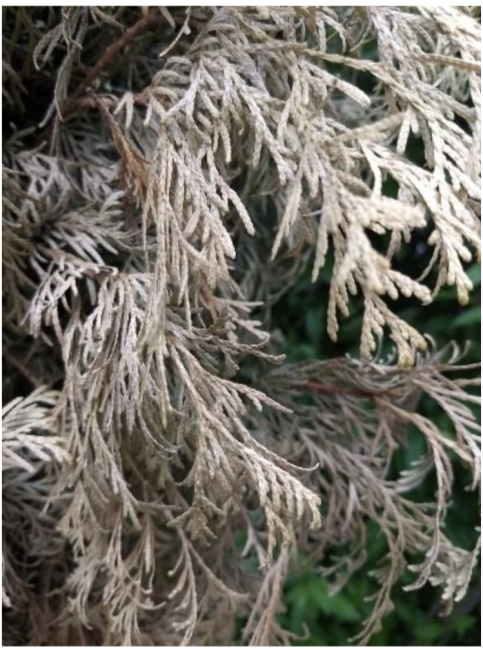
Winter burn refers to a type of damage to evergreen foliage that typically occurs over winter. Common symptoms are browning and dying from the tips of the foliage inward. Several factors cause winter burn on evergreens, including winter thaws while the ground is frozen, dry soil in autumn, a long period of very cold temperatures, winter sun on evergreen foliage or drying winter winds, poor siting of susceptible plants, recent planting/transplanting, and the individual plant’s susceptibility. Frequently affected plants include yews, junipers, boxwood, arborvitae, rhododendrons, dwarf Alberta spruce, and hemlock.
One good way to combat winter burn is to ensure that evergreens go into fall well-hydrated. Established plants, which have been in the ground over three years, should receive at least one inch of water a week into mid or even late November (if the ground has not frozen) from the trunk to the dripline of the tree or shrub if there is no rain. Two inches of water over that area may be needed in sandier soils. Newly transplanted conifers, which includes those planted within the past three years, need about two inches of water per week and possibly more in sandier soils.
Conifers don’t go into dormancy as deeply as deciduous trees that lose their leaves. Hence, a rise in winter temperatures (a ‘January thaw’) or even just direct hot sunlight on plants raises foliar and air temperatures above freezing. This can cause needles and scaly foliage to come out of dormancy, at least for a brief time. This phenomenon is especially common on plants near the west or south side of a white building where there is a lot of reflected heat and light. Brick buildings also can give off a lot of heat on west and south sides. Coming out of dormancy causes foliage to start photosynthesizing and respiring, giving off water from its foliar pores (called stomates) which it is unable to replenish via roots since the ground is frozen. Especially if the foliage and twigs were dry, to begin with due to dry fall weather, they desiccate, and winter burn symptoms appear. Interestingly, while winter burn often occurs during winter months, early spring (March or early April) can also be a time when winter burn develops if plants start to photosynthesize and respire while the ground is still frozen under snow and the temperature drops below freezing again for a long period of time, especially if accompanied by a lot of sun and wind.
Some plants may recover as new growth emerges, but many do not. You may recall that the winter of 2019 (the polar vortex) caused a lot of winter burn on a number of species due to long periods of excessive cold accompanied by sweeping winds. Some of the affected conifers only burnt a little on the outside edges, like yews, had latent buds a bit further back on the branch, and produced new needles. For others, they may not have had latent buds, or those buds were killed as well, and they did not recover.
In addition to watering into late fall, other protective measures are mulching and creating burlap ‘tents. Apply one to three inches of mulch (three inches is the maximum–more is not better!) evenly around the root zone to help retain the moisture in the soil. Do not pile mulch against the trunks, as this can cause damage. Evergreen shrubs can also be protected with burlap ‘tents.’ Put in stakes around the plant that are a few inches taller than the height of the plant and wrap burlap around the stakes. It can be secured with cable ties.
Finally, there are some products sold as anti-dessicants or anti-transpirants that should be avoided. Research indicates that these are not reliable because they tend to flake off too soon to protect the plants effectively, or that conversely, the product actually stays on too long into the growing season and interferes with the ability of the foliage to breathe. A fact sheet on the causes of and solutions for winter burn is available at the Plant Disease Diagnostic Clinic website.




